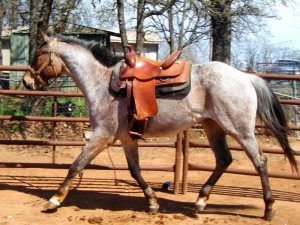 This will be the first post in a series describing how I go about training a horse. I am writing for the novice horseman in mind, so if some of this is redundant to your level of experience, please understand that there are beginners that may need to know every detail of the training process. This advice is not meant to be a beginner’s only resource—I always suggest that a person find a mentor in the horse training business, and watch from a safe distance before they ever try starting a colt themselves.
This will be the first post in a series describing how I go about training a horse. I am writing for the novice horseman in mind, so if some of this is redundant to your level of experience, please understand that there are beginners that may need to know every detail of the training process. This advice is not meant to be a beginner’s only resource—I always suggest that a person find a mentor in the horse training business, and watch from a safe distance before they ever try starting a colt themselves.
Putting the first ride on a colt is an amazing thing to experience. Much forethought and preparation will make it more successful, because there is a bit more to training horses than climbing into the saddle and hanging on. I would like to share some tips for getting that first ride to be a good one. Always keep in mind that every horse is an individual, and will have certain needs and weaknesses that need to be worked on.
First of all, make sure that you know your horse. Years of experience with horses will give you a quicker ability to judge, but you can still never fully know what will happen with a colt. There are a few things you can do to learn more about a horse before you ever step foot in the stirrup. You want to get to know the colt on the ground, first.
I like to start out in a round pen or a small, safe enclosure. Work on touching the horse all over. Use a brush to groom him, a lariat rope to toss over his back and around his legs, and a saddle blanket to drape over his back, neck, head, legs, tail, and belly. Watching his reactions to your movements and the different feel of each item you introduce will show you if he is going to be calm or spooky under saddle.
Accustom your colt to the saddle. I start by putting the saddle pad on, pulling it off, laying it under the colt’s belly, over his neck, and dragging it off his hindquarters. If he jumps, shies, or flinches, it just tells you that you need to repeat that action and work on it more before he’s ready to ride. Most hand-raised colts will accept all of this without much trouble, but there are also those with hang-ups and a “don’t touch me” attitude. So whatever the colt has issues with, that becomes your focus. A small pen or enclosure will keep the colt from getting too far from you, so just patiently persist in the actions he is trying to avoid, until he will willingly stand there and accept all of the touching and handling.
After you can saddle the colt without any trouble and where he isn’t constantly moving away or avoiding being handled, cinch him up securely and turn him loose in a round pen or arena where he can move freely. Use a lunge whip to encourage him to move around the pen in all gaits, letting him experience all of the squeaking leather, flopping stirrups, and tightened cinch.
If he wants to run and buck, by all means let him. This is the perfect time for the colt to “get the wiggles out” and discover that the saddle moves with him, and no matter what speed or ferocity he displays, it won’t come off or go away. This prepares his mind to accept that new weights, pressures, sounds, and feelings won’t hurt him and he doesn’t need to fear them. Don’t allow a gentle colt to just stand near you wearing the saddle—use a lariat or lunge whip to make him move out in a trot and lope.
Some colts will seem calm and unafraid, and they don’t willingly move quickly or buck with the saddle. But sometimes later on while they’re carrying a rider, something spooks them or “wakes them up” a little, and that same gentle colt will blow up and buck like no other. So be sure you get them to move fast, change directions, slow back down to a trot and then a walk, and discover that everything is just fine. Give them every opportunity to feel the saddle and let out a few bucks if they want to.
Don’t be dismayed if the colt bucks with the saddle. A lot of athletic colts do, and it doesn’t necessarily mean that they will buck with a rider. Also, don’t think that the colt has to buck with the saddle, as some horses just aren’t built that way, and don’t naturally want to buck. You just want to put the opportunity out there, and observe what the colt does with it. It will tell you a lot about the horse.

